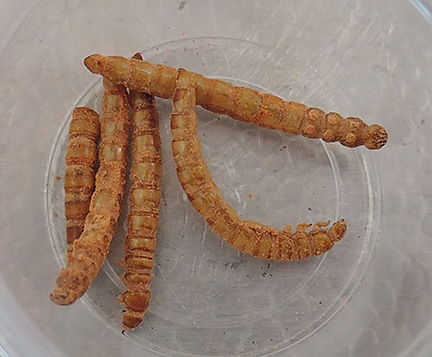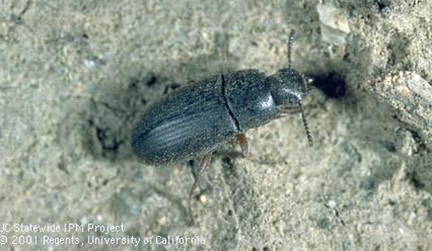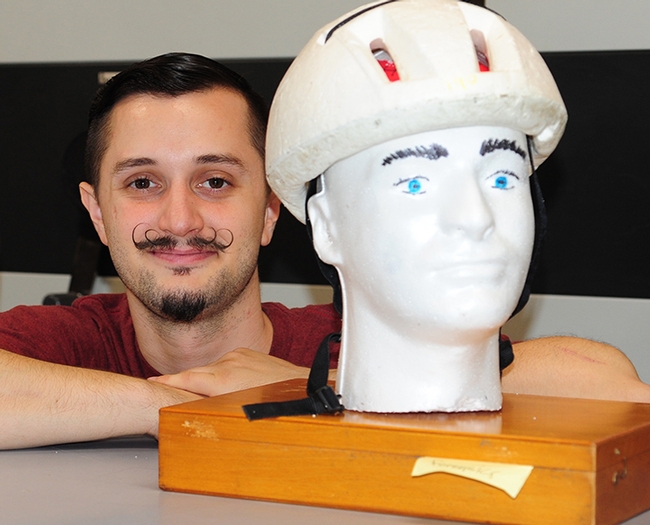
Drum roll...Time's up...
If you answered "mealworms"--or the larval form of the darkling beetle, family Tenebrionidae--that's correct.
And if you visit the UC Davis Bohart Museum of Entomology's open house ("Keep Calm and Insect On") from 1 to 4 p.m., Saturday, Dec. 5 in Room 1124 of the Academic Surge building, Crocker Lane, you'll encounter them chewing on a Styrofoam head, "The Recycling Man."
“It turns out that mealworms have some hidden talents,” said Lynn Kimsey, director of the Bohart Museum and professor of entomology at UC Davis. “They're not just good for feeding to pet reptiles or eating in snacks from HotLix. “These darkling beetle larvae have some dynamic gut bacteria.”

Enter Entomology undergraduate student Wade Spencer. You may know him from Bohart Associate Fran Keller's video of him costumed as a peacock jumping spider and performing a courtship dance. That video drew more than 2 million hits. (See previous Bug Squad piece on Wade Spencer with a link to Keller's video, or visit the Bohart Museum's Facebook page.)
So for his project, Spencer purchased a Styrofoam head online, obtained a Styrofoam insert from a bicycle helmet, and inserted 60 mealworms. That was on Nov. 18. Meanwhile, they're munching away. “Listen and you can hear them chewing," he said.
"This is a recycling project that's all in the head,” Spencer quipped.
(Learn more about darkling beetles on the UC Integrated Pest Management Program's website.) The insects can be pests of squash, pumpkins, dry beans and figs and the like. The wormlike larvae are commonly eaten by folks engaging in entomophagy.
Also at the Bohart Museum open house on Dec. 5, it's a time for show and tell. Bring insect or spider specimens and ask questions of the entomologists.
Native pollinator specialist Robbin Thorp, UC Davis distinguished emeritus professor of entomology at UC Davis, will be available for discussions on bumble bees and other pollinators, and will sign his books. He is the co-author of “Bumble Bees of North America: An identification Guide” (Princeton University) and “California Bees and Blooms: A Guide for Gardeners and Naturalists” (Heyday).
The Bohart Museum houses a global collection of nearly eight million specimens. It is also the home of the seventh largest insect collection in North America, and the California Insect Survey, a storehouse of the insect biodiversity. Noted entomologist Richard M. Bohart (1913-2007) founded the museum. Special attractions include a “live” petting zoo, featuring Madagascar hissing cockroaches, walking sticks and a rose-haired tarantula named “Peaches.” Visitors are invited to hold the insects and photograph them.
The museum's gift shop, open year around, includes T-shirts, sweatshirts, books, jewelry, posters, insect-collecting equipment and insect-themed candy.
The Bohart Museum hosts special weekend open houses throughout the academic year. All are free and open to the public and families are encouraged to attend. The regular hours are from 9 a.m. to noon and 1 to 5 p.m. Mondays through Thursdays. The museum is closed to the public on Fridays, Saturdays and Sundays and on major holidays. There is no admission but donations are appreciated.
More information on the Bohart Museum is available by contacting (530) 752-0493 or email bmuseum@ucdavis.edu. Tabatha Yang (tabyang@ucdavis.edu) does public education and outreach and conducts groups tours.
Attached Images:
